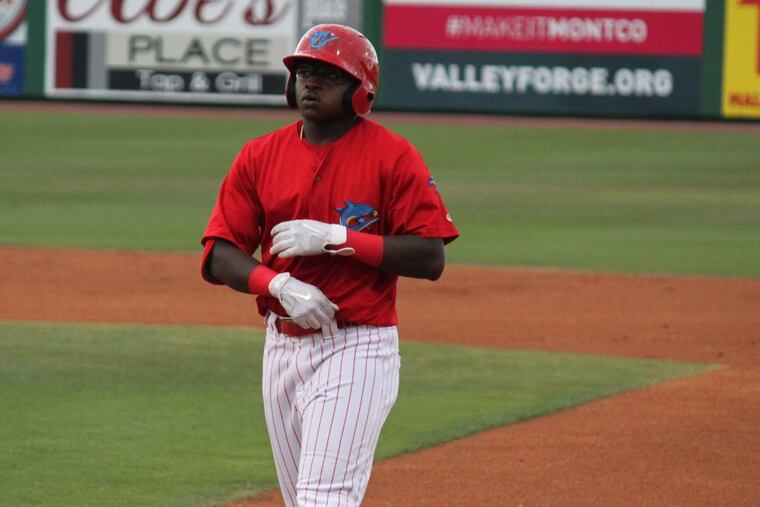Phils still in position to take risk in draft
Johnny Almaraz has taken some risks by selecting high school players in past first rounds. He should do so again this year.

It was a high-risk business Johnny Almaraz decided to get into when he accepted the Phillies' job as the scouting director in October 2014 and he opted to go the high-risk route with his first-round picks in his first two drafts. He will conduct his third draft this week, starting with the first round Monday night.
A lot of people were surprised two years ago when the Phillies took Cornelius Randolph, a high school outfielder from Georgia, with the 10th overall pick in the draft.
"I thought he was a bad-bodied guy without a position," a baseball executive said last week. "He had a dipping action in his hands that made me wonder if he'd be able to handle better pitching. I saw him lunch up on mediocre pitching, but when I watched what his hands did I had some questions."
Those questions persist even though Almaraz said Friday that both Randolph and Mickey Moniak, last year's No. 1 overall pick out of a Southern California high school, are right where he thought they would be at this early point in their careers. Randolph, who turned 20 on June 2, has struggled this season at high-A Clearwater after missing half of last season at low-A Lakewood with a shoulder injury.
It is far too early to declare anything about Randolph, but more than a few players drafted after him are on a better track at the moment. Among those players are Scott Kingery and Thomas Eshelman, both taken in the second round out of colleges and both seemingly on the fast track to the big leagues.
Oh, yeah, and both are in the Phillies' minor-league system, too.
Kingery, 23, was taken with the 48th overall pick the same year Randolph was taken 10th and is in the midst of a dominating season with double-A Reading, where he leads the Eastern League in home runs with 17. Eshelman joined the organization in the December 2015 in the Ken Giles trade after being selected by the Astros 46th overall seven months earlier.
A little side note about the 46th pick in the draft: That selection has been magic for the Phillies in the past. Scott Rolen was taken with that pick in 1993 and three years later the team took Jimmy Rollins in that slot. Rolen and Rollins, according to Baseball America, have the highest WAR rankings of any two players ever taken in that slot.
As for Moniak, he is having an OK first full professional season at low-A Lakewood, but not as good as Cincinnati's top prospect, Nick Senzel, who was taken second overall out of the University of Tennessee last June. Only time will tell how the two careers unfold. Regardless, there will always be a debate about which way to go – college or high school — in the draft.
"In dealing with [college] players, a lot of them are what they are," Almaraz said. "Their true ability that they possess now really isn't going to change a whole lot."
High school players, on the other hand, can mature into something spectacular or fizzle and fade away. High risk and high ceiling are the scouting terms. There must also be high anxiety for the men picking them.
The other consideration is where an organization is at in terms of developing players. Given that the Phillies have the worst record in baseball, you might think they'd be more inclined to load up on college players that have a chance of getting to the big leagues faster.
Almaraz described this draft as being loaded with quality college pitching.
"We will get our share of college pitchers," he said. "They are big, mature and strong. They will be fast movers through the minor-league system."
The baseball executive who earlier talked about Randolph does not agree with that assessment.
"I think it's a mediocre college crop this year," he said. "I think there's a little more depth with high school position players. There are a handful of college position players that would be interesting in the top 10 and only a couple of college pitchers worth taking in that eight-to-10 range."
Vanderbilt's Kyle Wright and Louisville's Brendan McKay are considered the top two college pitchers and neither is expected to still be on the board when the Phillies make the eighth pick. Both a baseball executive and an American League scout said they would not select either North Carolina's J.B. Bukauskas or Florida's Alex Faedo as high as No. 8. Baseball America's latest mock draft has Bukauskas going to the Phillies, but that means little.
While Almaraz is on record as saying he could load up on college pitching in this draft, the baseball executive believes that the Phillies should invest in their fair share of high-ceiling high school players.
"For me, where they're at, they should still take the best ceiling player available with just a minimal amount of risk," he said. "I think when you get away from taking the best player available, you can outsmart yourself. I think, for example, Oakland has drafted itself into mediocrity in recent years."
Since 2007, Oakland has taken 25 players in the first two rounds and 20 of them have been college selections.
"The Phillies have enough players that are coming right now at the higher levels that they can afford to take some risk," the baseball executive said.
The best high-ceiling, minimal risk pitcher in this draft, according to the baseball executive, is Trevor Rogers, a 6-foot-6 high school lefty from New Mexico.
In a couple of years, we'll look back to see how Rogers is doing unless, of course, the Phillies actually take him. Then we will be checking in on him a lot more often.